Practice Free PL-600 Exam Online Questions
DRAG DROP
A company plans to implement a model-driven app.
The company has the following requirements:
• Short Message Service (SMS) data must be visible on the model-driven app timeline.
• Store location data must be referenced from a SQL server database.
• Customer data must be audited and only edited by specific users.
You need to recommend the table type for each requirement.
Which table types should you recommend? To answer, drag the appropriate solutions to the correct requirements. Each solution may be used once, more than once, or not at all. You may need to drag the split bar between panes or scroll to view content. NOTE: Each correct selection is worth one point.


HOTSPOT
You are designing a Power Platform solution for a company that provides in-home appliance maintenance. When a customer schedules a service appointment, a dispatcher assigns one technician for a specific time and location.
The solution must capture information about the technician assigned to each appointment and the list of tools that the technician must bring to the appointment.
You need to recommend the data type for the captured information.
Which data type should you use? To answer, select the appropriate options in the answer area. NOTE: Each correct selection is worth one point.
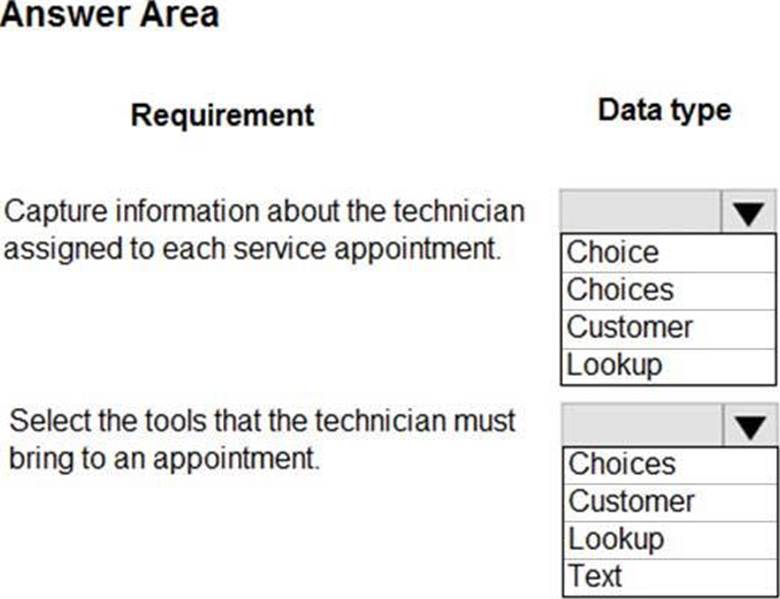
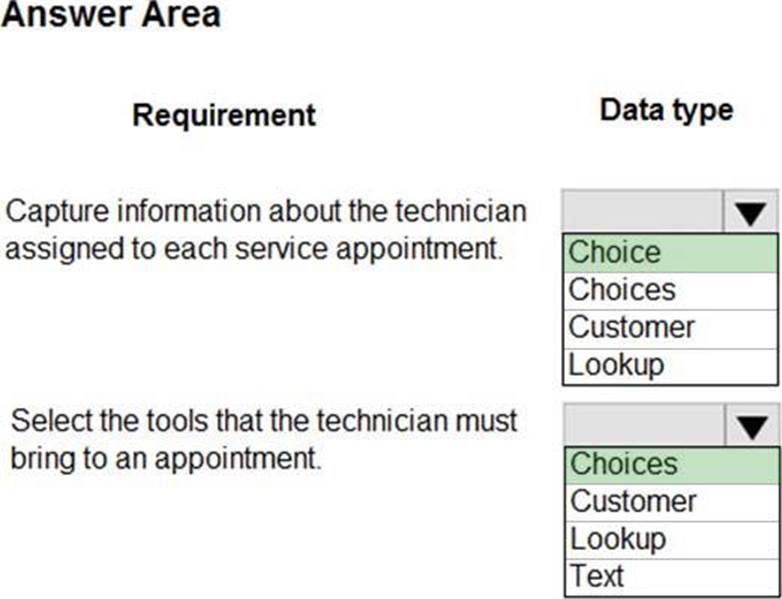
Explanation:
Box 1: Choice
Like Choices below, but can only select one of the option.
Box 2: Choices
You can customize forms (main, quick create, and quick view) and email templates by adding multi-select columns that are called Choices. When you add a choices column, you can specify multiple values that will be available for users to select. When users fill out the form they can select one, multiple, or all the values displayed in a drop-down list.
Reference: https://docs.microsoft.com/en-us/powerapps/maker/data-platform/types-of-fields
HOTSPOT
You are designing a Microsoft Power Platform solution for a national repair service. The service has a 24-hour call center for customers to call and schedule repairs.
The solution dispatches a technician to troubleshoot and repair customer issues. Customers sign into a customer portal to view and log information concerning the repairs. The repair service contracts with third party technicians for repair jobs
The solution must meet the following requirements:
• Dispatch technicians to troubleshoot and repair customer issues
• Call center must log customer issues.
• Third -party technicians must be able to access assigned repair service jobs.
You need to recommend an authentication strategy.
Which authentication models should you use? To answer, select the appropriate options in the answer area.
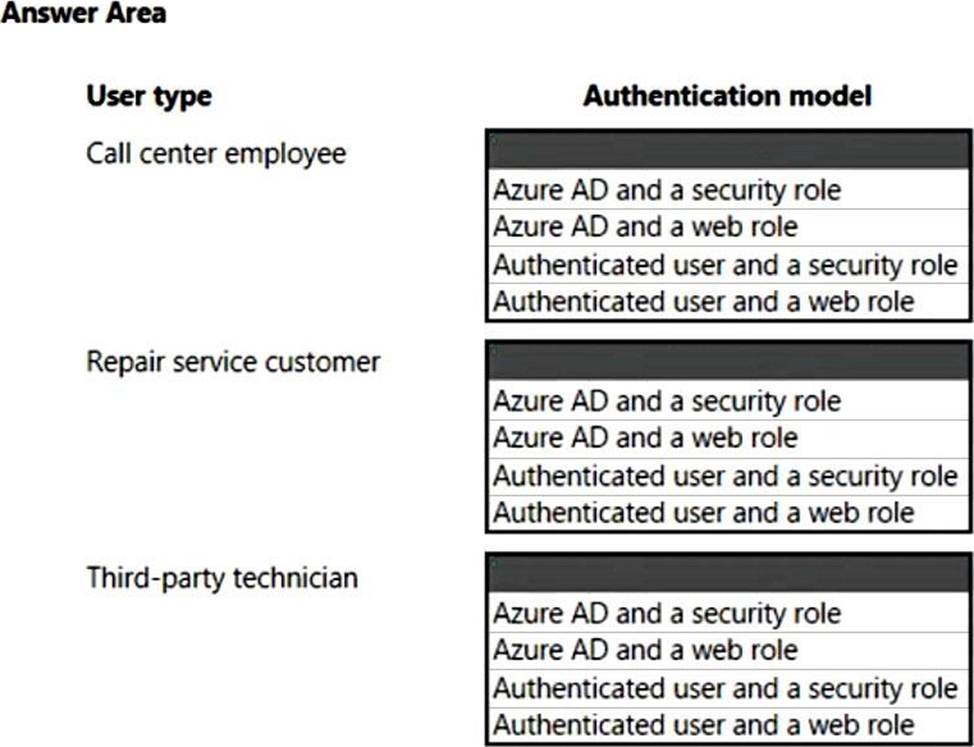
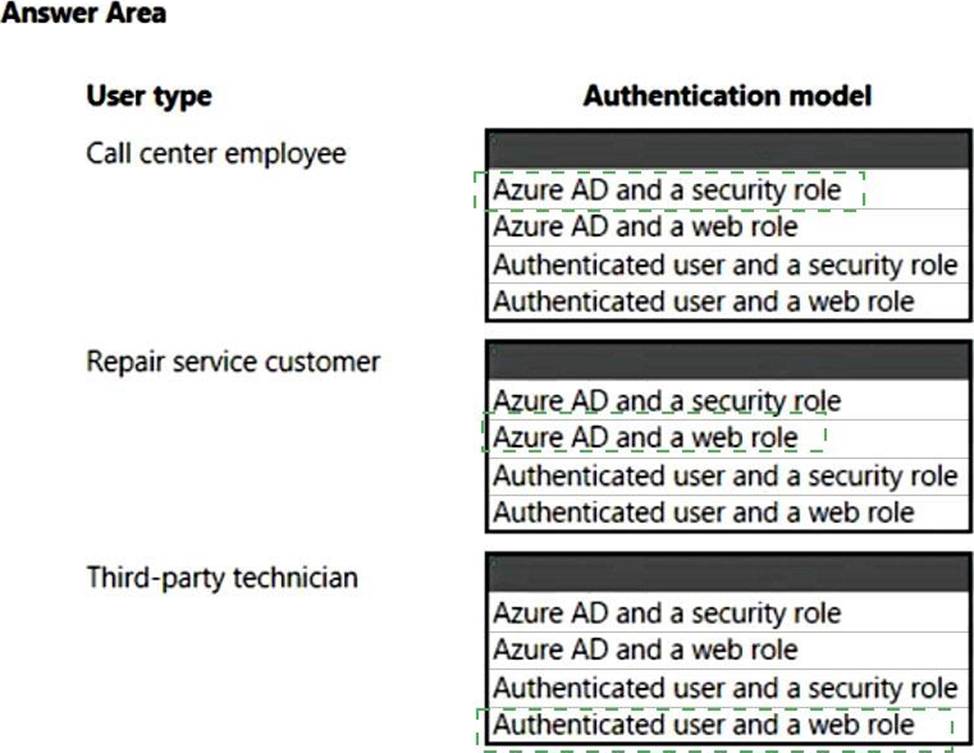
HOTSPOT
You are designing a Microsoft Power Platform solution for a national repair service. The service has a 24-hour call center for customers to call and schedule repairs.
The solution dispatches a technician to troubleshoot and repair customer issues. Customers sign into a customer portal to view and log information concerning the repairs. The repair service contracts with third party technicians for repair jobs
The solution must meet the following requirements:
• Dispatch technicians to troubleshoot and repair customer issues
• Call center must log customer issues.
• Third -party technicians must be able to access assigned repair service jobs.
You need to recommend an authentication strategy.
Which authentication models should you use? To answer, select the appropriate options in the answer area.


You need to recommend the field type to use for configuring meal selections during reservation.
Which field type should you recommend?
- A . Global Option Set
- B . Lookup
- C . Option Set
- D . Two Options
B
Explanation:
Scenario:
✑ Customers can select a meal when they make a reservation and can save the meal choices as a customer preference.
✑ The company offers two types of meals: standard and vegetarian. Meal types can be temporarily unavailable. The airline is considering offering other meal types, such as gluten-free and low-sodium options.
In PowerApps Option set is one of the field types you can use in your Entity. The information type that Option Set stores is a list of text values. And here comes the Option Set advantage C once you define its text values you can centrally managed it. Example:
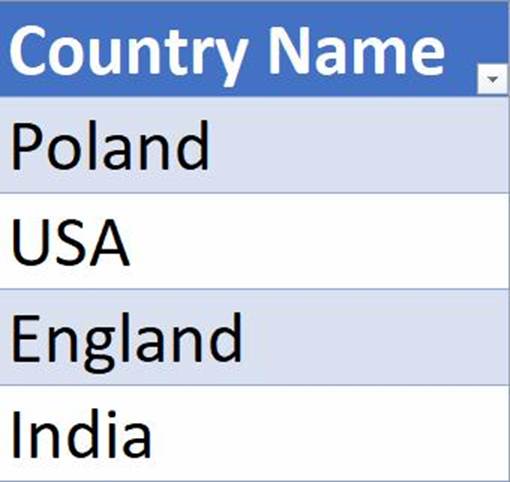
Reference: https://michalguzowski.pl/how-to-work-with-option-set-in-powerapps/
HOTSPOT
A company plans to deploy multiple Microsoft Dataverse environments. You are supporting the go-live process.
The company reports the following access issues:
• Users can access account records but cannot read a column m the table.
• A licensed user receives an insufficient permission error when opening leads.
• A licensed user does not appear in the list of users available for security assignment.
You need to resolve the issues.
What should you do? To answer, select the appropriate options in the answer area NOTE: Each correct selection is worth one point.
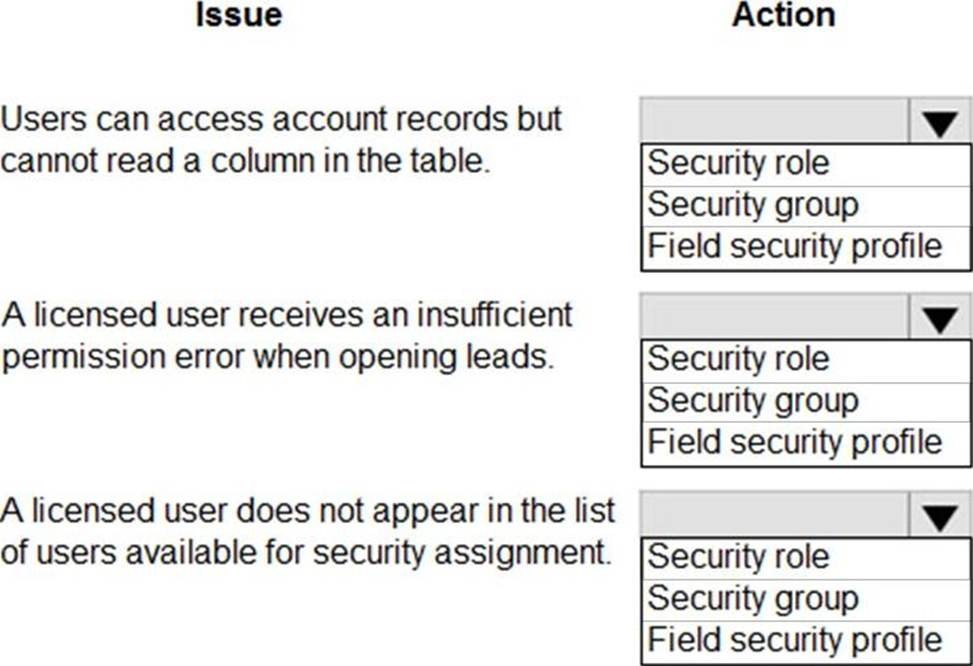
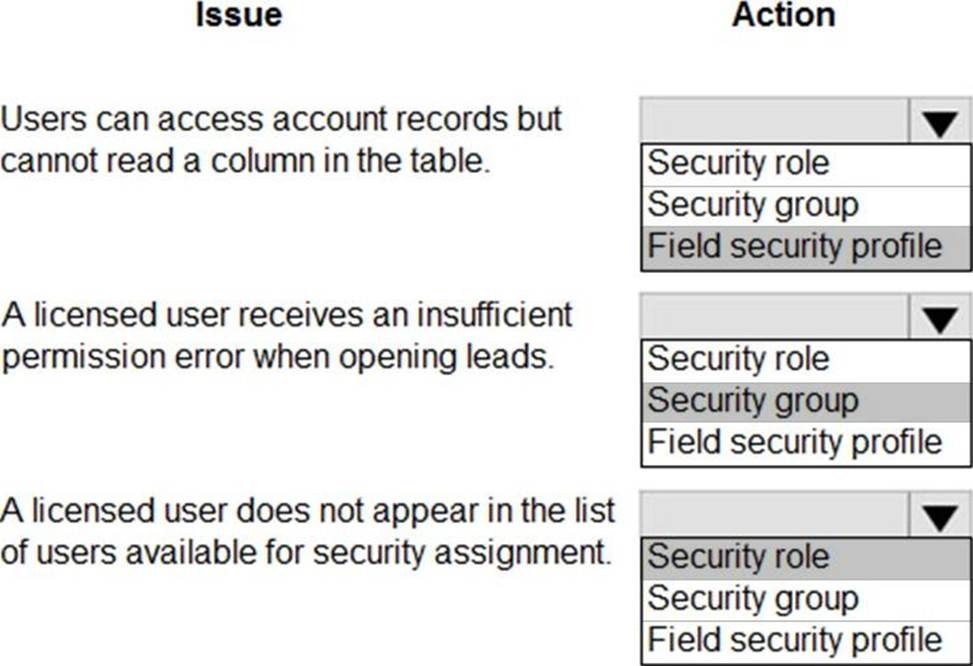
Explanation:
Reference: https://docs.microsoft.com/en-us/powerapps/developer/data-platform/field-security-entities
You are implementing a model-driven app for a national chain of retail stores.
You have the following requirements:
• Store employees must be able to view data for their store only.
• Regional managers must be able to view data for all stores in a region.
• The reporting team must be able to view all data across all stores.
You need to configure system security.
Which three security methods should you use? Each correct answer presents part of the solution. NOTE: Each correct selection is worth one point.
- A . Manager hierarchy
- B . Account hierarchy
- C . Owner teams
- D . Microsoft Entra ID security group
- E . Security roles
HOTSPOT
You need to ensure that the solution meets the data security and compliance requirements.
What should you recommend? To answer, select the appropriate options in the answer area. NOTE: Each correct selection is worth one point.
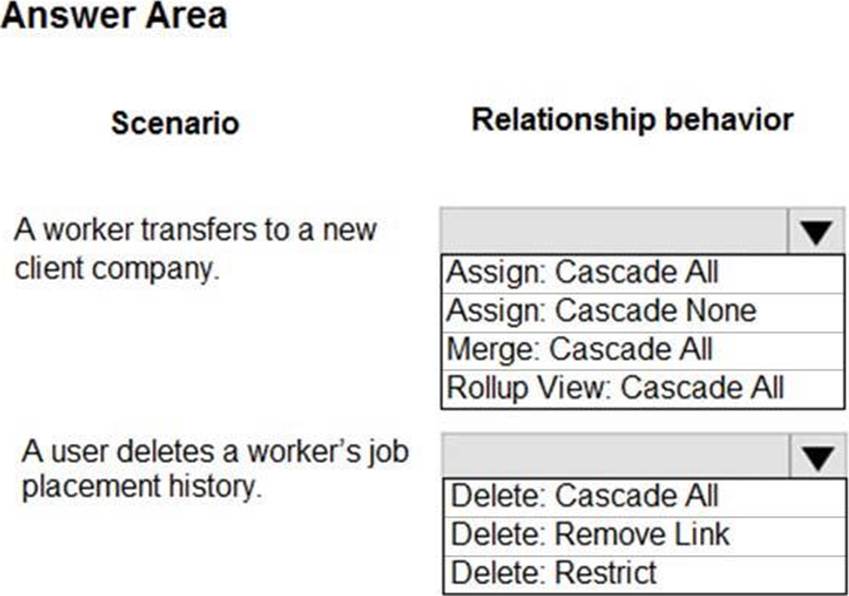
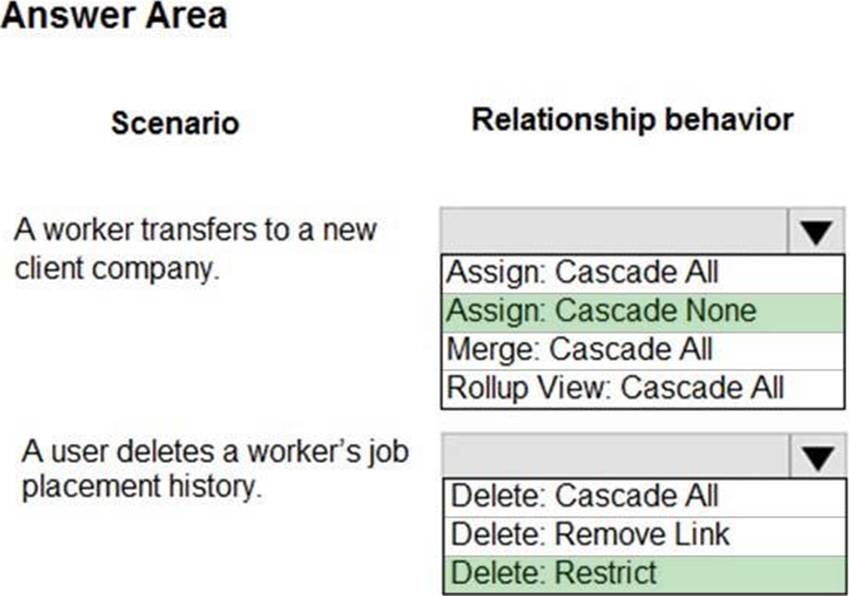
Explanation:
Box 1: Assign: Cascade None
Scenario: Worker still records must be archived after ten years and are then removed from the main system.
Assign: The referenced table record owner is changed.
Cascade None: Do nothing.
Incorrect Answers:
Cascade All: Perform the action on all referencing table records associated with the referenced table record.
Box 2: Delete: Restrict
Scenario: Worker information must not be deleted from the system while skill and job placement history records for the worker exist in the system.
Referential, Restrict Delete: In a referential, restrict delete relationship between two tables, you can navigate to any related rows. Actions taken on the parent row will not be applied to the child row, but the parent row cannot be deleted while the child row exists. This is useful if you do not want child rows to become orphaned. This forces the user to delete all of the children before deleting the parent.
Reference: https://docs.microsoft.com/en-us/powerapps/maker/data-platform/data-platform-entity-lookup
HOTSPOT
An automobile parts manufacturer wants to replace an existing system with a Microsoft Power Platform solution. The company has been experiencing undesired data changes in their current system. The cause of the changes is due to the relationships that are set up between tables in the database that the system uses.
The new solution must meet the following requirements:
• Track vehicle manufacturers and models.
• Display a list of all models that a manufacturer produces.
• Ensure that each vehicle model can be associated to only one manufacturer.
• Delete all associated models when a user deletes a manufacturer.
• Automatically populate information from the manufacturer when creating a new model from the model list on the manufacturer page.
You need to recommend table relationships to meet the business requirements.
Which relationship settings should you recommend? To answer, select the appropriate options in the answer area. NOTE: Each correct selection is worth one point.


A company uses Microsoft Power Platform with assets that include solution files, flat files, custom code, HTML files, and data.
You need to use application lifecycle management (ALM) to deploy the assets to Microsoft Dataverse.
Which tool should you use?
- A . Package deployer
- B . Solution packager
- C . Configuration Migration tool
- D . Microsoft Power Platform Build Tools
